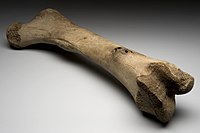
Photo from wikipedia
The northernmost rocks in the India‐Asia collision zone that were off‐scraped from continental crust of the Indian plate are the nappes of the so‐called Tibetan Himalaya, and the paleogeographic area… Click to show full abstract
The northernmost rocks in the India‐Asia collision zone that were off‐scraped from continental crust of the Indian plate are the nappes of the so‐called Tibetan Himalaya, and the paleogeographic area between the Tibetan Himalaya and modern undeformed India is known as “Greater India.” Paleomagnetic data have long been used to infer that the paleolatitudinal distance between the Tibetan Himalaya and India, defining the width of Greater India, was in Early Cretaceous, Triassic, and Ordovician time not more than some hundreds of kilometers wider than today (e.g., Bian et al., 2019; Huang et al., 2015; Klootwijk & Bingham, 1980; Qin et al., 2019; Torsvik et al., 2009; van Hinsbergen et al., 2012, 2019; Figure 1). This is consistent with (i) shortening records of the Himalaya that show that some 500–600 km (perhaps up to 900 km) of upper continental crust was stacked (in two episodes: in the latest Paleocene‐earliest Eocene (~55 Ma), and since the latest Oligocene (~30–25 Ma) with no demonstrated record of nappe accretion in the intervening period (Long et al., 2011); (ii) with tectonic reconstructions of the west Australian margin that argue that during the Early Cretaceous breakup of east Gondwana, continental India did not extend beyond a prominent fracture zone (the Wallaby fracture zone) limiting its width to ~800 km (Ali & Aitchison, 2005; Gibbons et al., 2012); and (iii) with seismic tomographic constraints that the modern Indian continent that is imaged below Tibet today is of similar shape and area as predicted by a Gondwana fit of Greater India against the Wallaby fracture zone (van Hinsbergen et al., 2019).
Journal Title: Tectonics
Year Published: 2019
Link to full text (if available)
Share on Social Media: Sign Up to like & get
recommendations!